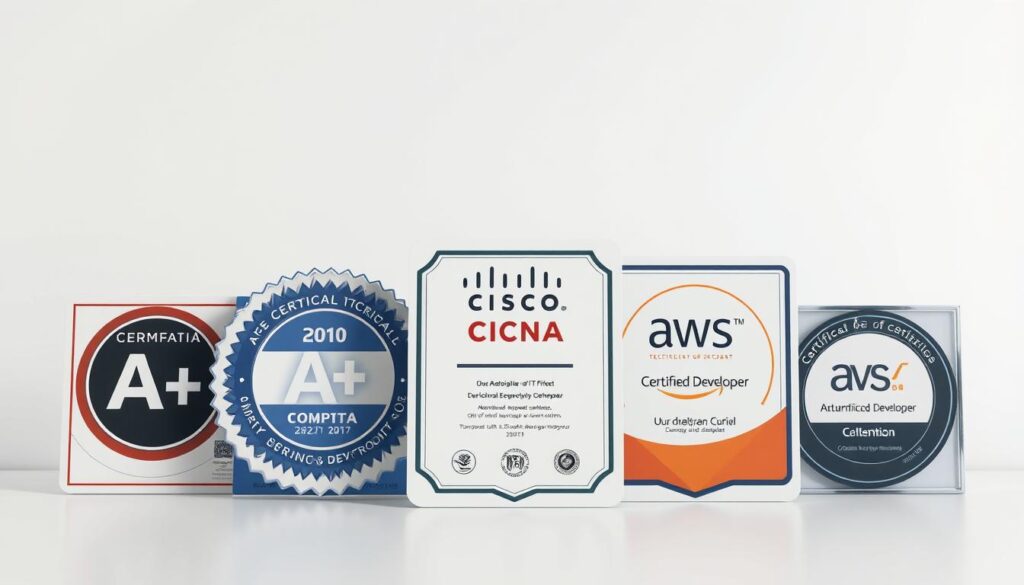Crafting a standout application for technical roles requires balancing hard skills with soft abilities. This guide cuts through the noise with actionable strategies and real-world samples from professionals hired at top firms. You’ll learn how to structure your document to emphasize both technical expertise and customer-centric experience.
Inside, you’ll find 13 proven templates optimized for Applicant Tracking Systems (ATS). These examples show how to quantify achievements like reducing system downtime or improving user satisfaction rates. Tools like RoboApply simplify formatting while ensuring your content aligns with industry standards.
Discover how to highlight certifications, troubleshoot metrics, and prioritize keywords hiring managers seek. We’ll show you where to place critical details like network security experience or software proficiency for maximum impact. By the end, you’ll have a polished, ATS-friendly application ready for 2025 opportunities.
Key Takeaways
- 13 editable templates from professionals hired at Fortune 500 companies
- Step-by-step formatting tips to beat ATS algorithms
- Proven methods to showcase technical and interpersonal skills
- Ready-to-use sections for certifications and project highlights
- RoboApply’s AI tools for instant optimization and keyword matching
- Data-driven strategies to quantify problem-solving impact
Introduction: Setting the Stage for Your IT Support Analyst Resume
Your application document acts as a strategic bridge between your expertise and employer needs. With hiring teams scanning submissions faster than ever, every word must prove your ability to solve technical challenges while maintaining user trust. “Think of your resume as a troubleshooting log,” advises a Fortune 500 IT hiring manager. “We want to see problem-resolution patterns, not just skill lists.”
Modern technical roles demand measurable proof of both hardware/software mastery and communication abilities. Instead of writing “Provided user support,” showcase specific achievements: Reduced ticket resolution time by 35% through PowerShell automation scripts while maintaining 98% user satisfaction scores. Tools like AI-powered resume builders help transform generic statements into impact-driven content.
Structure your experience section to answer three critical questions:
- What systems have you maintained or upgraded?
- How did your actions improve operational efficiency?
- What soft skills ensured smooth user interactions during crises?
Prioritize certifications like CompTIA A+ or Microsoft Azure Fundamentals near the top. For hybrid roles requiring client-facing abilities, include metrics that demonstrate conflict resolution success rates. Remember: your document isn’t just a career summary—it’s a value proposition tailored for 2025’s competitive tech landscape.
Understanding IT Support Analyst Job Requirements
Landing a technical role starts with decoding employer expectations. Modern organizations seek candidates who blend system expertise with user-focused problem-solving. Let’s break down critical elements hiring teams prioritize.

Mastery of ticketing systems forms your operational backbone. ServiceNow and Jira proficiency shows you can track 50+ daily requests while maintaining SLA compliance. Pair this with cross-platform fluency – employers expect troubleshooting skills across Windows, macOS, and Linux environments.
Your technical toolkit must include:
- Network diagnostics (DNS configuration, packet loss analysis)
- Hardware repair workflows for workstations and servers
- Cloud platform navigation (AWS EC2 instances, Azure AD)
Don’t underestimate soft skills. A Dell hiring manager notes: “We promote technicians who explain encryption protocols to non-tech users as clearly as rebooting routers.” Quantify collaboration wins, like reducing escalations by 40% through improved documentation.
Cybersecurity awareness separates contenders from frontrunners. Highlight experience implementing MFA rollouts or phishing response protocols. For hybrid roles, emphasize remote support tools like TeamViewer and VPN configurations that maintained 99.9% uptime during transitions.
Curate your experience section using proven templates that spotlight relevant achievements. List certifications like CompTIA Security+ near education details. Tools like automated formatting assistants ensure your layout meets technical recruiter preferences while keeping content focused on measurable impacts.
Choosing the Right Resume Format
Your document’s layout determines whether hiring teams see your best qualifications. Formatting errors account for 43% of technical role rejections, according to LinkedIn’s 2024 hiring report. Start with these four rules: reverse-chronological order, header contact details, targeted expertise, and concise presentation.
Single-Column vs. Multi-Column Options
Use single-column layouts to ensure ATS systems parse your content correctly. Multi-column designs often scramble information during digital processing. A clean structure lets recruiters quickly spot your career progression and technical competencies.
Place your skills section below the summary for immediate visibility. List certifications like CompTIA Network+ before education if you have under five analyst years experience. This approach emphasizes current capabilities over dated coursework.
PDF vs. DOCX Format
Always submit your document as a PDF. Word files may display differently across devices, breaking your careful formatting. Exception: Only use DOCX if the job posting specifically requests editable files for manual tracking.
Keep your resume to one page unless you’ve led major infrastructure projects. Senior professionals can extend to two pages with quantifiable leadership achievements. Include a headshot only if applying to European markets or executive roles requiring media kits.
Optimizing Your Resume for Applicant Tracking Systems (ATS)
Your document’s success with automated systems hinges on design choices as much as content. Over 75% of applications get filtered out before human review, making ATS compatibility non-negotiable. Start with fonts like Arial or Calibri – their clean lines ensure scanners read text accurately. Avoid decorative styles that might distort character recognition.

Structure matters just as much as style. Use standard headings like “Skills” and “Experience” so algorithms map your qualifications correctly. One recruiter notes: “Tables and text boxes often break parsing – stick to linear layouts with consistent spacing.” Tools like ATS optimization checklists help identify formatting risks.
Simple Fonts and Clear Layouts
Modern sans-serif fonts improve readability for both machines and hiring teams. Keep font sizes between 10-12 points for body text. Use bold or italics sparingly – excessive formatting can trigger parsing errors. Double-check margins to prevent text from getting cut off during digital processing.
Avoiding Complex Graphics
Infographics and icons might look appealing but often confuse ATS software. Instead, quantify achievements with numbers: “Reduced ticket backlog by 40%” beats visual charts. Save your file as “John_Doe_Technical_Support_Resume.pdf” to ensure seamless uploads. Test compatibility by pasting content into Notepad – if sections stay intact, you’re clear.
Integrate keywords naturally from job descriptions. For example, list “network troubleshooting” under skills if the role requires it. Platforms like AI-driven resume builders auto-match terms while maintaining organic flow. Remember: clarity always trumps creativity in ATS environments.
Leveraging RoboApply's AI Tools for a Standout Resume
Modern job seekers need smart solutions to cut through application noise. RoboApply’s platform transforms your career documents into precision tools that showcase technical expertise while meeting strict ATS requirements.
AI Resume & Cover Letter Builder
The system’s core feature crafts polished documents in minutes. You’ll get tailored suggestions for showcasing network troubleshooting or software deployment achievements. One user reported: “RoboApply helped me highlight cloud migration projects that landed three interviews in two weeks.”
Key features include:
- Automatic keyword extraction from job descriptions
- Customizable templates for different roles
- Real-time grammar and tone adjustments
ATS Optimizer for Error-Free Resumes
This tool acts as your digital editor, scanning for formatting issues that trip automated systems. It flags dense text blocks and suggests white space improvements while maintaining keyword density. You’ll see instant feedback on how well your technical skills match specific employer needs.
RoboApply’s Chrome extension tracks applications across platforms, while the interview coach prepares you for common scenario questions. Pair these tools with professional templates to create documents that demonstrate both system mastery and user support abilities.
Real-World IT Support Analyst Resume Examples
Effective career documents showcase problem-solving patterns through concrete achievements. Let’s examine how professionals translate technical expertise into measurable business impacts.
https://www.youtube.com/watch?v=lwsn81qEoqs
Team Leadership in Enterprise Environments
A senior specialist at Dell directed 5 technicians across 3,000+ service requests. Their approach reduced recurring system issues by 30% through automated update workflows. Customer satisfaction reached 98% across all resolved tickets while maintaining 99.9% infrastructure availability.
Cloud Solutions Implementation
An IBM professional upgraded data management systems using secure cloud architecture. Their storage redesign slashed retrieval times by 40%, directly boosting workforce productivity by 25%. This case demonstrates how technical upgrades create ripple effects across user experiences.
Notice how both examples:
- Connect system improvements to user outcomes
- Use percentages to quantify efficiency gains
- Balance team achievements with individual contributions
These models prove that hiring managers value clear cause-effect relationships between technical actions and organizational benefits. Structure your experience sections to mirror this results-focused approach.
Highlighting Technical Skills and Certifications
Technical expertise forms the backbone of your qualifications. Hard skills like network troubleshooting and cloud management prove your ability to resolve system issues. Soft abilities ensure you translate complex solutions into user-friendly guidance.

Prioritize concrete tools in your skills section. List specific operating systems like Windows 11 or Ubuntu Linux. Include programming languages such as Python for automation tasks. A hiring manager at Cisco notes: “Candidates who detail PowerShell scripting experience get 40% more interview callbacks.”
Balance technical depth with teamwork examples. Show how you explained firewall configurations to non-tech staff during security upgrades. Quantify collaboration wins: “Reduced escalations by 25% through improved documentation practices.”
Certifications validate your knowledge. Place Microsoft Certified: Azure Fundamentals or CompTIA A+ near the top. Use categories like:
- Network Protocols: DNS, DHCP, VPN
- Software Tools: ServiceNow, VMware, Active Directory
- Security: MFA implementation, phishing response
Organize your skills using an AI-driven resume builder to ensure hiring managers quickly spot critical competencies. This approach demonstrates both technical mastery and the communication skills needed for modern hybrid roles.
Crafting a Powerful Resume Summary or Objective
Your opening statement acts as a career snapshot that hooks recruiters in under 10 seconds. This critical section determines whether hiring teams keep reading or move to the next candidate. Choose between summary and objective based on your career stage and goals.

Tailoring Your Message for the Right Experience Level
Seasoned professionals should lead with a summary showcasing measurable results. Start with action verbs and specific metrics: “Reduced average ticket resolution time by 28% through automated scripting” demonstrates technical and efficiency skills. Highlight career progression by mentioning system upgrades or cross-departmental projects.
Newcomers benefit from objectives that connect transferable skills to employer needs. Instead of “Seeking growth opportunities,” try: “Aspiring professional with CompTIA A+ certification aiming to leverage network troubleshooting training to enhance user support efficiency.” Focus on customer service abilities gained through internships or volunteer work.
A Microsoft hiring manager advises: “We look for summaries that answer ‘What can you fix for us?’ in the first line.” Whether you have two years experience or ten, align your statement with the job description’s top three requirements. Use tools like RoboApply’s AI analyzer to match keywords while maintaining natural flow.
Quantifying Achievements with Metrics
Numbers speak louder than words when proving your technical expertise. Hiring teams look for candidates who translate daily tasks into measurable business impacts. Start by tracking how your actions improved workflows or reduced costs.
Using Measurable Data to Stand Out
List ticket resolution rates to show efficiency. For example: “Closed 45+ technical requests per week while maintaining 92% user satisfaction scores.” This demonstrates both speed and quality.
Highlight system improvements with percentages. Proactive maintenance might appear as: “Boosted system uptime by 28% through predictive hardware upgrades.” Include time metrics like “cut average resolution time from 2 hours to 45 minutes using automated diagnostics.”
Training initiatives gain weight with participation numbers. Mention “educated 150+ staff on cybersecurity protocols, reducing phishing incidents by 60%.” Cost-saving figures like “$12K annual savings from optimized cloud storage” prove fiscal responsibility.
For structured guidance, explore proven technical resume templates that showcase metrics effectively. These examples reveal how top candidates position data to highlight problem-solving scale.
FAQ
How do I choose between PDF and DOCX formats for my application?
Use PDF to preserve formatting across devices. Some employers request DOCX for easier parsing by older ATS software—check job descriptions for specific preferences.
What technical certifications boost credibility for support roles?
Prioritize CompTIA A+, Microsoft Certified: Azure Fundamentals, or Cisco CCNA. Include expiration dates for time-sensitive certifications like ITIL 4 Foundation.
Can I use graphics or icons to highlight skills?
Avoid complex visuals that break ATS parsing. Use simple bullet points and standardized section headers like “Technical Proficiencies” for better machine readability.
How should I quantify achievements without management experience?
Focus on ticket resolution metrics: “Reduced average resolution time by 30% through improved troubleshooting workflows” demonstrates measurable impact without supervisory roles.
What soft skills matter most for entry-level positions?
Highlight active listening, adaptability to new systems, and collaborative problem-solving. Pair these with technical terms like “Active Directory management” to show balanced capabilities.
How do I address career gaps in support roles?
Frame gaps as skill-building periods: “Certified in cybersecurity best practices while managing family obligations” maintains professionalism while explaining absences.
Should I include home lab projects on my resume?
Yes—detail specific configurations like “Built Active Directory test environment to practice group policy implementations” to showcase hands-on technical initiative.


















